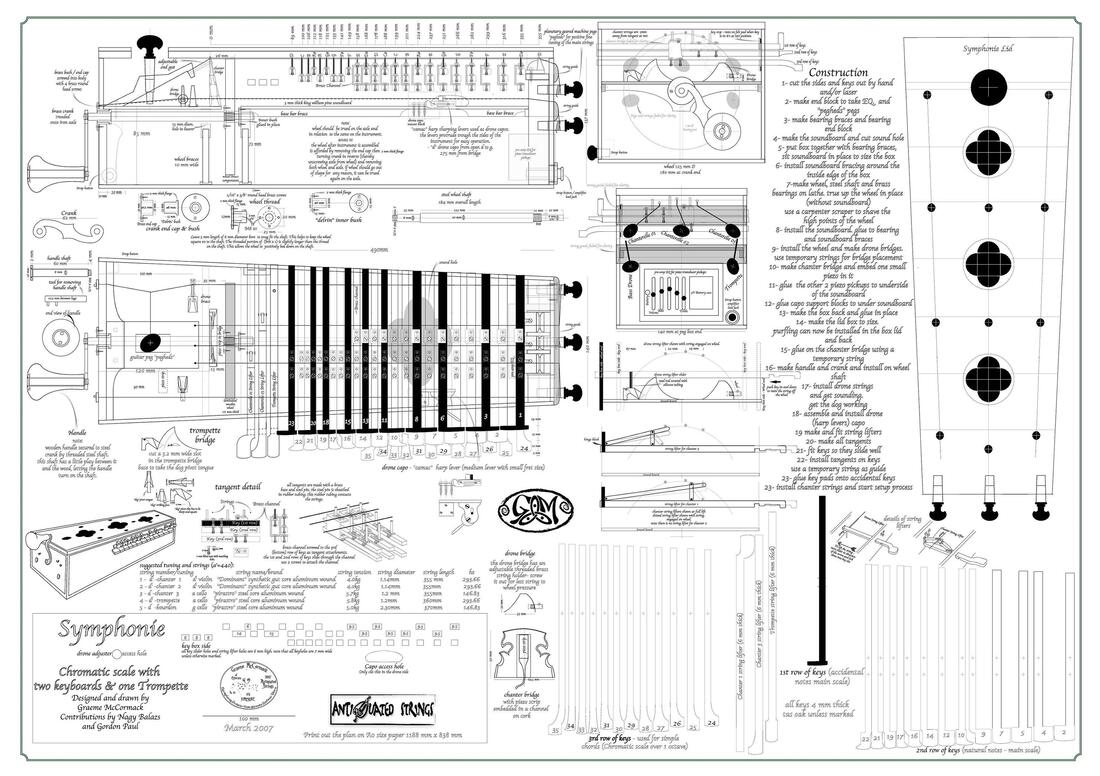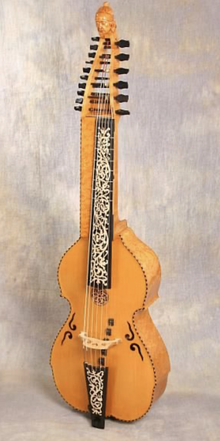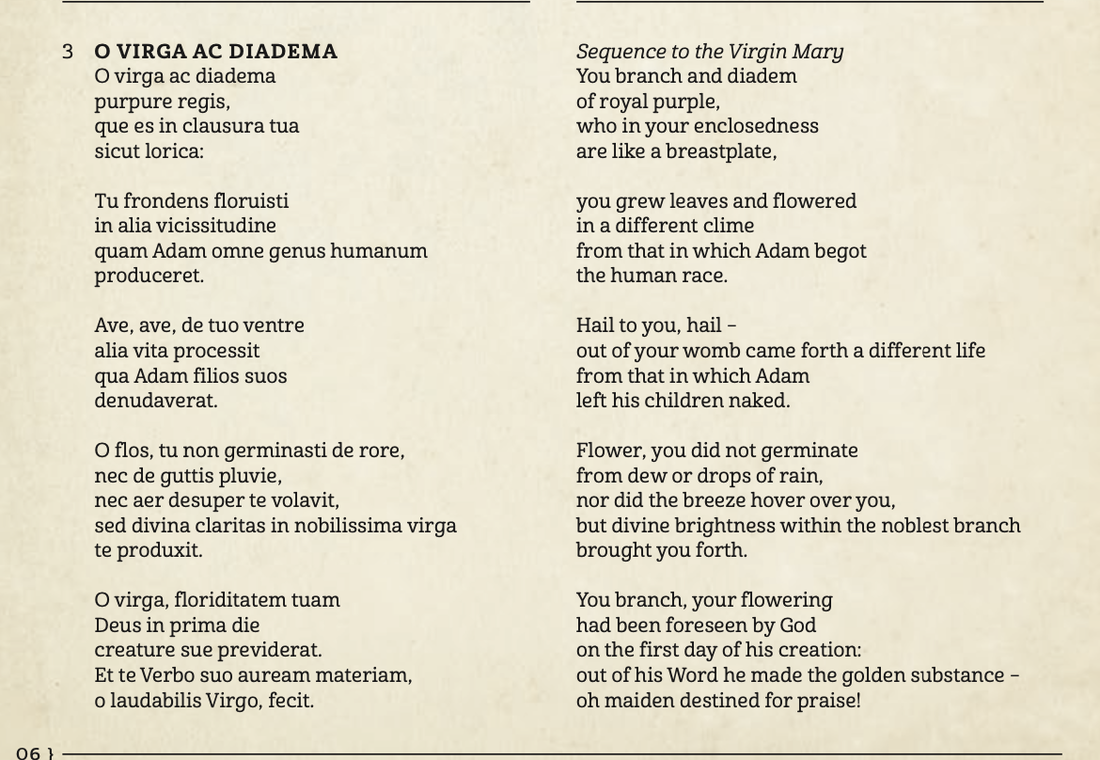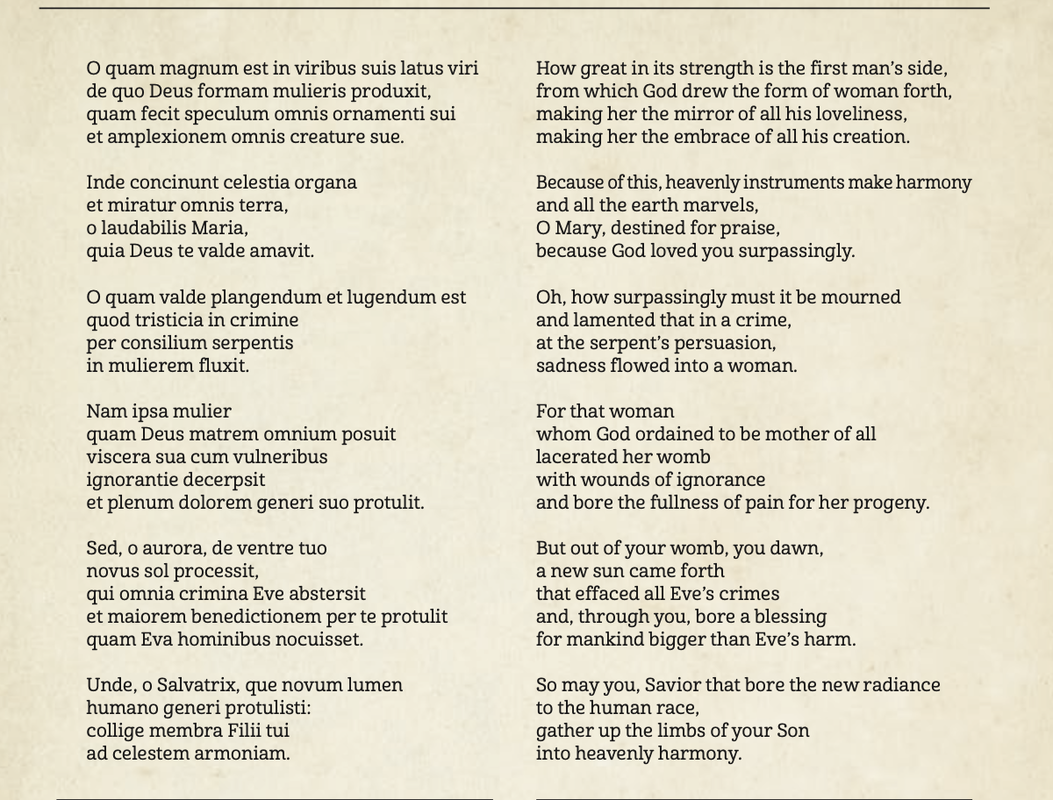 The hurdy-gurdy is generally thought to have originated from fiddles in either Europe or the Middle East some time before the eleventh century A.D.[2] One of the earliest forms of the hurdy-gurdy was the organistrum, a large instrument with a guitar-shaped body and a long neck in which the keys were set (covering one diatonic octave). The organistrum had a single melody string and two drone strings, which ran over a common bridge, and a relatively small wheel. Due to its size, the organistrum was played by two people, one of whom turned the crank while the other pulled the keys upward. Pulling keys upward is cumbersome, so only slow tunes could be played on the organistrum.[4] The pitches on the organistrum were set according to Pythagorean temperament and the instrument was primarily used in monastic and church settings to accompany choral music. Later on, the organistrum was made smaller to let a single player both turn the crank and work the keys. The solo organistrum was known from Spain and France, but was largely replaced by the symphonia, a small box-shaped version of the hurdy-gurdy with three strings and a diatonic keyboard. At about the same time, a new form of key pressed from beneath was developed. These keys were much more practical for faster music and easier to handle; eventually they completely replaced keys pulled up from above. Medieval depictions of the symphonia show both types of keys. During the Renaissance, the hurdy-gurdy was a very popular instrument (along with the bagpipe) and the characteristic form had a short neck and a boxy body with a curved tail end. It was around this time that buzzing bridges first appeared in illustrations. The buzzing bridge (commonly called the dog) is an asymmetrical bridge that rests under a drone string on the sound board. When the wheel is accelerated, one foot of the bridge lifts from the soundboard and vibrates, creating a buzzing sound. The buzzing bridge is thought to have been borrowed from the tromba marina (monochord), a bowed string instrument. The hurdy gurdy comes in when the percussive footwork comes in - its the neverending fiddlelike drone. The sound is somewhere between pipes and fiddle. the fiddle comes in later  Theorbo' is an anglicized form of the Italian word 'tiorba', which was a colloquial name for a large instrument of the lute family. It was developed in Florence during the 1580s. The instrument was known initially by its formal academic name 'chitarrone', derived from the Greek 'kythara'. 'Tiorba' was only used initially in informal contexts, but by the middle of the 17th century, it had completely usurped 'chitarrone' as the normal name in everyday use.  There are only about 50 historical barytons for which we have evidence, either in the form of documents or the instrument itself. Many of the latter have been modified from their original form. Thus, tracing the history of the baryton is a difficult task.[3] Concerning the origin of the baryton, the instrument probably originated in England in the early 17th century when the characteristics of two instruments, the viola da gamba and the bandora, were combined into one hybrid instrument".[4] Early evidence for the existence of the baryton is found circa (1644). The instrument had six bowed strings as well as metal strings behind the neck. The thumb of the left hand plucked the metal strings, which were made to sound with the bowed notes. If this information is accurate, the baryton must have been known in England before 1625, the end of King James' reign."[5] The earliest baryton that survives today dates from 1647; it was made by Magnus Feldlen in Vienna and is currently in the musical instrument collection of the Royal College of Music in London.[6 The instrument was never particularly popular, but "it acquired a certain cachet in courtly circles, particularly in south Germany and Austria". The compositions for the instrument by Haydn and his students and colleagues represented a last hurrah for the baryton; by the early 19th century it had gone out of style and ceased to attract new compositions.[8] The Haydn-era baryton was different from earlier versions in a crucial respect: the sympathetic strings were tuned a full octave higher than previously. This helped the baryton to stand out from the other instruments (viola, cello) in the baryton trio,[9] Uilleann pipes The first bagpipes to be well attested for Ireland were similar, if not identical, to the Scottish Highland bagpipes that are now played in Scotland. The union or uilleann pipe emerged during the early 18th century and were far quieter and sweeter in tone than their mouth-blown predecessors. Essentially their design required the joining of a bellows under the right arm, which pumped air via a tube to a leather bag under the left arm, which in turn supplied air at a constant pressure to the chanter and the drones (and regulators in the case of the Irish Uilleann pipes). The earliest surviving sets of uilleann pipes date from the second half of the 18th century, but it must be said that datings are not definitive. The Uilleann pipes were often used by the Protestant clergy, who employed them as an alternative to the church organ.[citation needed] As late as the 19th century the instrument was still commonly associated with the Anglo-Irish, e.g. the Anglican clergyman Canon James Goodman (1828–1896) from Kerry, who had his tailor-made uilleann pipes buried with him at Creagh (Church of Ireland) cemetery near Baltimore, County Cork. His friend, and Trinity College colleague, John Hingston from Skibbereen also played the uilleann pipes. Another piping friend of Canon Goodman, Alderman Phair of Cork (founder of the pipers club in Cork in the 1890s) had Goodman's pipes recovered from Creagh cemetery. They were later donated to Cork piper Michael O'Riabhaigh, who had re-established the (by then extinct) pipers club in Cork in the 1960s.
1 Comment
I know that as we head into this winter, that all of us are craving and missing making music together. Last week we listened to a series of tunes with a focus of discovering the layers of the arrangements. This week I wanted to take us somewhere much more vulnerable. The thought of standing on a stage on my own has never appealed to me, I can do it, but I have always gravitated to ensemble. however, when I remove the audience, I do love making music on my own within a space, where no one can hear, be it an empty parking garage, singing to snow covered peaks in the silence of a fresh snowfall, or enjoying the reverb that is only achievable when standing IN the bathtub. (it’s the best reverb you can get in most modern homes.) I find I am most creative in the late hours of the night, when the rest of the world has gone to bed, some folks find this space in the morning before anyone else rises. Some times being alone can be beautiful. Sometimes to be alone we need to sing to break the loneliness, and hear ourself echo back. Sometimes one musician is enough to create a beautiful experience. I hope we can all find this for ourselves as musicians in the coming months Tonight we are going to travel through 4 solo performances. 2 are with video, 2 are recordings. The first is the Magnificent Martin Hayes, performing live Irish Arts Center NYC 2016. An incredibly talented and humble man, the tunes he picks are not showy, yet, his delivery of each is far from simple. Hildegard of Bingen OSB (German: Hildegard von Bingen; Latin: Hildegardis Bingensis; 1098 – 17 September 1179)(81 yrs), also known as Saint Hildegard and the Sibyl of the Rhine, was a German Benedictine abbess, writer, composer, philosopher, Christian mystic, visionary, and polymath of the High Middle Ages.[1][2] She is one of the best-known composers of sacred monophony, as well as the most-recorded in modern history.[3] She has been considered by many in Europe to be the founder of scientific natural history in Germany.[4] O Virga Ac Diadema - Sequence to the Virgin Mary If you’ve ever been in a cathedral, they are architectural structures that that make me feel both the need to whisper, and the wish to shout and sing out with joy. I’ve only once gotten to sing in a cathedral, and then we were politely but firmly asked to leave once we finished singing North West Passage. So before you listen to this next piece, let’s build a space that we are comfortable singing in to take in this celebration through music. You are in a large space. Columns rise up on either side of you, holding the high-vaulted ceiling. Not unlike great tall trees, reaching up and branching across the sky. There is a warm light coming through stained glass windows between the pillars, casting fractals on the polished floors. it could be morning, it could be late afternoon. As you walk between the columns each step echoes for an infinity. now for a moment, as we walk down the long length of the room, picture a person who you love, it could be a friend, it could be a relative, children, grandchildren, a stranger that you met on the bus, it could be someone long gone but well loved and missed. It may be that there are many who come to mind, hold them all, now you’ve reached the front of the hall. on the raised dias before you is a beautiful work of art that embodies the memories you just recalled. It might be a marble statue or a painting, a stained glass window, a silent movie, or entirely abstract. there is a bench beside you, should you wish to sit, and as the music plays, take in the details of the art before you, or close your eyes and exist in the space you have created. Now shared with a song composed over 800 years ago. "Romance Anónimo" (Anonymous Romance) is a piece for guitar, also known as "Estudio en Mi de Rubira" (Study in E by Rubira), "Spanish Romance", "Romance de España", "Romance de Amor", "Romance of the Guitar", "Romanza" and "Romance d'Amour" among other names. Its origins and authorship are currently in question. It is suspected of originally being a solo instrumental guitar work, from the 19th century. The style of the piece is that of the Parlour music of the late 19th century in Spain or South America, having a closed three-part form: the first in the minor key and the second being in the major key, with the third being a restatement of the first. The earliest recording of "Romance" is on a cylinder (from the "Viuda de Aramburo" label[3][4][5]) featuring guitarists Luis and Simon Ramírez, made in Madrid sometime between 1897 and 1901. Christina Sandsengen was born in a small town in the middle of Norway in 1987. She started to play the piano at the age of seven and gave her first public performance in the following year. When she was 15, she started to play the guitar, and fell in love with it. From that moment onwards, she decided to devote herself solely to the guitar Christina Sandsengen plays a wide range of repertoire, with particular focus on Romantic music. Her passion for the classical guitar inspired her to establish the Oslo Gitarskole, Norway’s leading school for classical guitar. Carl Friedrich Abel (22 December 1723[n 1] – 20 June 1787)[2][3] was a German composer of the Classical era. He was a renowned player of the viola da gamba, and produced significant compositions for that instrument. Although bass viols superficially resemble cellos, viols are different in numerous respects from instruments of the violin family: the viol family has flat rather than curved backs, sloped rather than rounded shoulders, c holes rather than f holes, and five to seven rather than four strings; some of the many additional differences are tuning strategy (in fourths with a third in the middle—similar to a lute—rather than in fifths), the presence of frets, and underhand ("German") rather than overhand ("French") bow grip.[9] Performed by Johanna Rose, Nerd Bonus: Mechanical Knitting MachineSo since I have time to either a) worry about the state of the world or b) go down nerd rabbit holes these days, I'm aiming to chose option B as often as possible... and when ever I see a friend getting particuarly bogged down by option A in their own life, I start sending them videos that bring me joy, whether that is the Viola Da Gamba performance above, or the wonder of the world below. Some how I ended up watching this video and I love it so much! such a cool machine!!! We listened to each of these tracks twice, the first time to listen to lyrics or the "first layer" of music, which is what ever you instinctively listen to. The second time through we focused on listening to the way the arrangements are layered and built to support the song. There were definitely some really interesting and strong opinions, some "I never need to hear that agains" while others loved that same track and the feelings switched. However these tracks make you feel, dig into why, try to figure out what is about them that you do or do not enjoy. Lean into the discomfort. The first track is Alasdair Fraser and Natalie Haas - Calliope Meets Frank
Bros Landreth - Greenhouse
Josh Ritter - Best is for the Best
I don't have much of a writeup for this one. I picked music that I felt was reflective and beautiful, and we listened to some of the tracks more than once. The First track - the road to Aviles is a song from the Spanish Civl War. A beautiful rendition of I'll be seeing you, sung by Billie Holiday, in 1944. Benny Goodman & Peggy Lee - We'll Meet Again Eric Whitacre, the master of beautiful dissonance. Tonight we are going on a wild ride! We’re going to listen to some tracks with what I would definitely consider explicit content, some rap music, even some swearing, I’ll try to give you the heads up of what we are about to listen to, and the tools to be able to enjoy all of them. I’ve got 4 pieces to share with you tonight, and I think you’re going to be surprised, I had an absolute blast putting this together, This is all music that I really love, and have been inspired by over the years. So, our first track, if I was going to write a Parental advisory for this I would say it has themes of violence, & suicide. Despite that, this piece of music has been recorded innumerable times, we’re going to listen to a version by a group that isn’t known for censoring their lyrical content, and can often come across as extremists. What makes something appropriate? inappropriate? extreme? It’s often unfamiliarity, sometimes its a cultural clash, sometimes it’s the musical packaging. So buckle up and here we go! This next track, which tells the story of a young musician from a low income family attempting to raise himself up out of poverty with his art is a masterpiece of poetry, it starts with an open mic event. It is 0.006 % questionable/explicit language and it’s actually really just 3 borderline words, and 2 uses of an expletive, 5 out of the 793 words used in the lyrics are enough that this has been labeled as E for Explicit Content. I’m going to post the lyrics in the chat box so you can follow along, because it goes by so quickly, and the rhymes are brilliant Emimem - lose yourself released 2002 I was 12 when it came out, I listened to this so many times, SO lets jump right into the next track! A beautiful song about rape and murder by Gillian Welch And for an amazing example of what can happen when composers and creators are open to using influences from all over. Hamilton. A Musical (Technically I think you could actually call it an opera) that uses hiphop/rap to deliver a mesmerizing show. |
What do we do?Join us to be inspired by music from around the world, no preparation, prerequisites, or practicing required. I’ll read a short composer bio, highlight some historically relevant material or interesting context, we’ll listen to a piece of music, and then take the time to reflect on what we heard, ask questions, and explore. Archives
March 2021
Categories |



 RSS Feed
RSS Feed